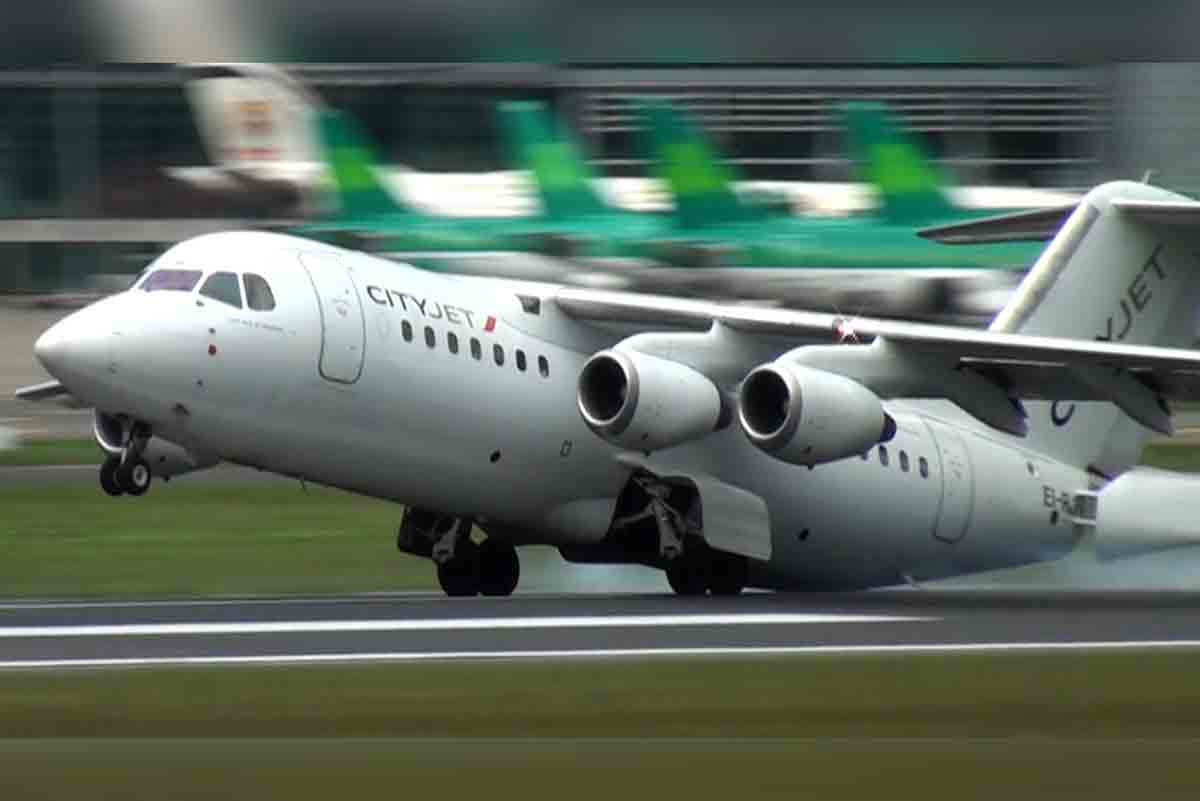In this part, you will tell me what you can see in this picture and what you think is happening in it. After that, I will ask you some questions. Look at the picture carefully. You may take a few moments to think before you start talking.
Are the instructions clear?
SUGGESTED INTERACTION:
ICAO 5:
Right off the bat, we’ve got a tail strike event here!
In this picture, we can see a medium multi-engined passenger jet, with high wings and a T-tail, operated by Cityjet during its landing procedure touching down on the runway.
I say that because I can clearly see the speed brakes popping out, and there’s light smoke streaming from the tires due to the touchdown, which signifies a landing.
As I mentioned earlier, that’s a typical case of a tail strike, and incidents like this are most likely to crop up when the aircraft’s nose is pitched too high during takeoff or if the aircraft touches down with the nose too high, causing the tail to smack into the runway surface.
Tail strikes can come about due to various reasons, such as: the pilot mishandling pitch control, encountering wind shear, or facing technical glitches.
ICAO 4: In this picture I can see a medium passenger jet with high wings and T-tail touching the runway.
The speed brakes are opened and there is light smoke leaving the tires due to the braking action.
In my opinion it looks like a tail strike during the landing.
Examiner: What do you think happened before this picture was taken?
SUGGESTED INTERACTION:
ICAO 5: Before this picture has been taken, I believe the aircraft could have been approaching in a completely unstabilized condition at a low speed and with a fairly high pitch for landing.
Consequently, the crew was unable to successfully carry out a smooth landing, ending up in a tail strike.
ICAO 4: Before this picture was taken I believe the aircraft was approaching unstabilised for landing and then, they suffered a tail strike.
Examiner: Imagine that this picture has just been taken: What do you think will happen next?
SUGGESTED INTERACTION:
ICAO 5: Next, following this incident, I believe all passengers will disembark, the aircraft will be brought in to the hangar for a thorough inspection and maintenance, and it will later be turned around for the operations as soon as possible.
ICAO 4: Passengers will disembark and mechanics will check all the damages to be fixed.
Examiner: What may cause a tail strike?
SUGGESTED INTERACTION:
ICAO 5: Tail strikes can occur due to various reasons, such as incorrect pitch control by the pilot, unstabilised approach, wind shear, technical issues, unbalanced cargo, cargo loose, early rotation or over-rotation.
ICAO 4: Tail strikes is caused by windshear, unbalanced cargo, early rotation or over-rotation and unstabilised approach.
Examiner: Why can a tail strike cause severe structural damage to the aircraft fuselage?
SUGGESTED INTERACTION:
ICAO 5: Because during a tail strike, the tail of the aircraft, which includes the tail cone and empennage (vertical and horizontal stabilizers), collides with the runway surface. The force of this impact can be substantial, especially if the aircraft is moving at a significant speed during takeoff or landing.
ICAO 4: Because the fuselage of the aircraft isn’t made for impacts..
Now, I am going to read a statement to you and then you will have to tell me to what extent you agree or disagree with it.
“Some aircraft designs are more likely to suffer a tail strike than others, so if there’s a combination of bad design, bad weather and inappropriate rotation techniques, then the probability of tail strike becomes higher.”
SUGGESTED INTERACTION
ICAO 5: I agree with this statement because a tail strike can be caused by many factors including bad handling, weather situations involving strong winds, cargo issues and specially the design of some aircraft.
Stretched planes are more likely to suffer tail strikes than others, therefore an extensive training on proper takeoff and landing procedures is required.
ICAO 4: I agree with this statement because a tail strike can be caused by many factors and all these factors combined with a bad design, an aircraft very stretched for example: It will have a big chance to suffer a tail strike during the landing or Takeoff.
Se você gostou desse post do Call to Fly, compartilhe utilizando os canais de Mídia!!
Abraço!! Rumo ao topo!
Leandro Araujo
Hey! Sua Ajuda é super importante!
Se você gostou ou acha esse website interessante e quiser ajudá-lo a mantê-lo em atividade constante nem que seja com R$ 1,00, o botão de doações e QR Code do PIX encontra-se logo abaixo. Obrigado!.

